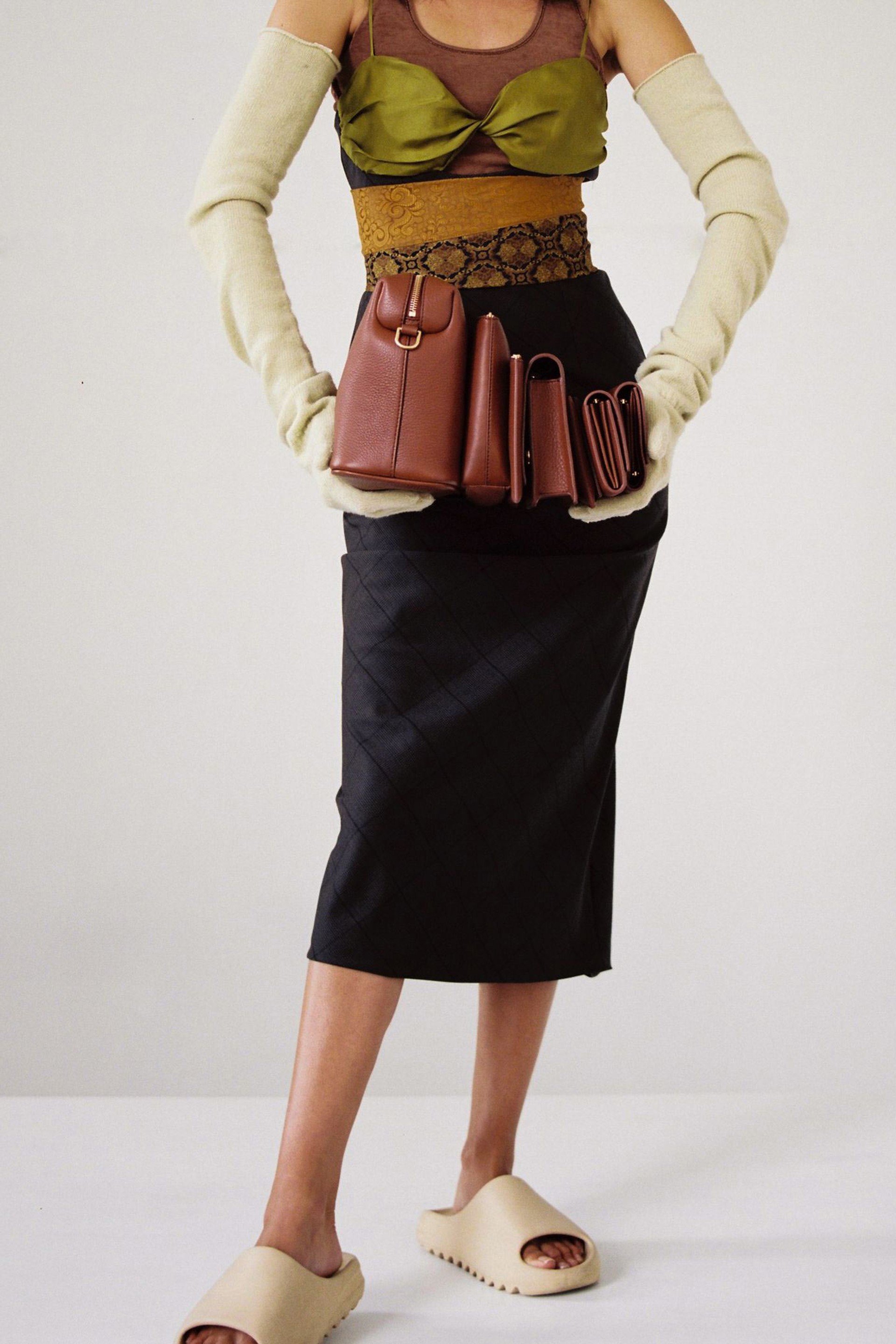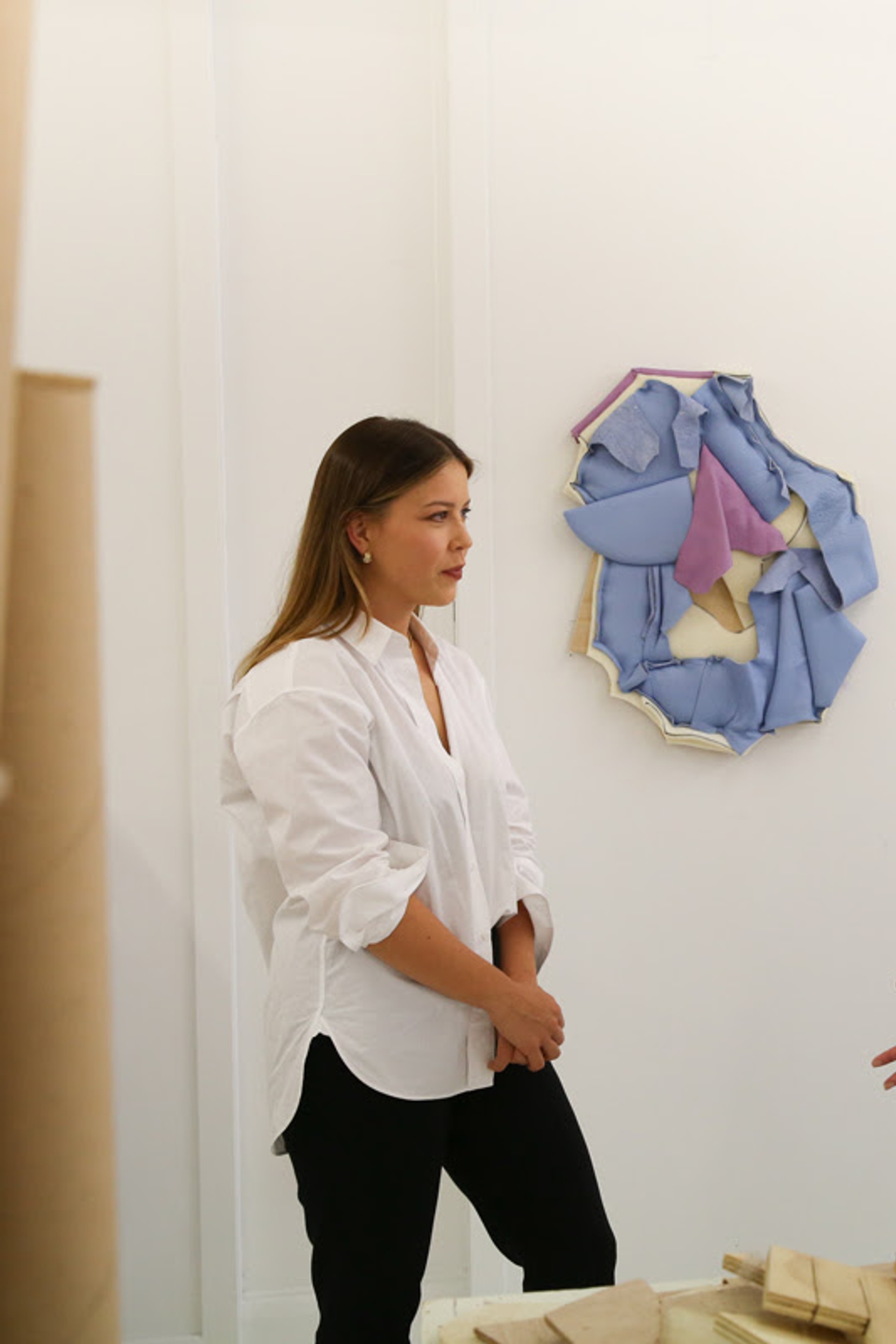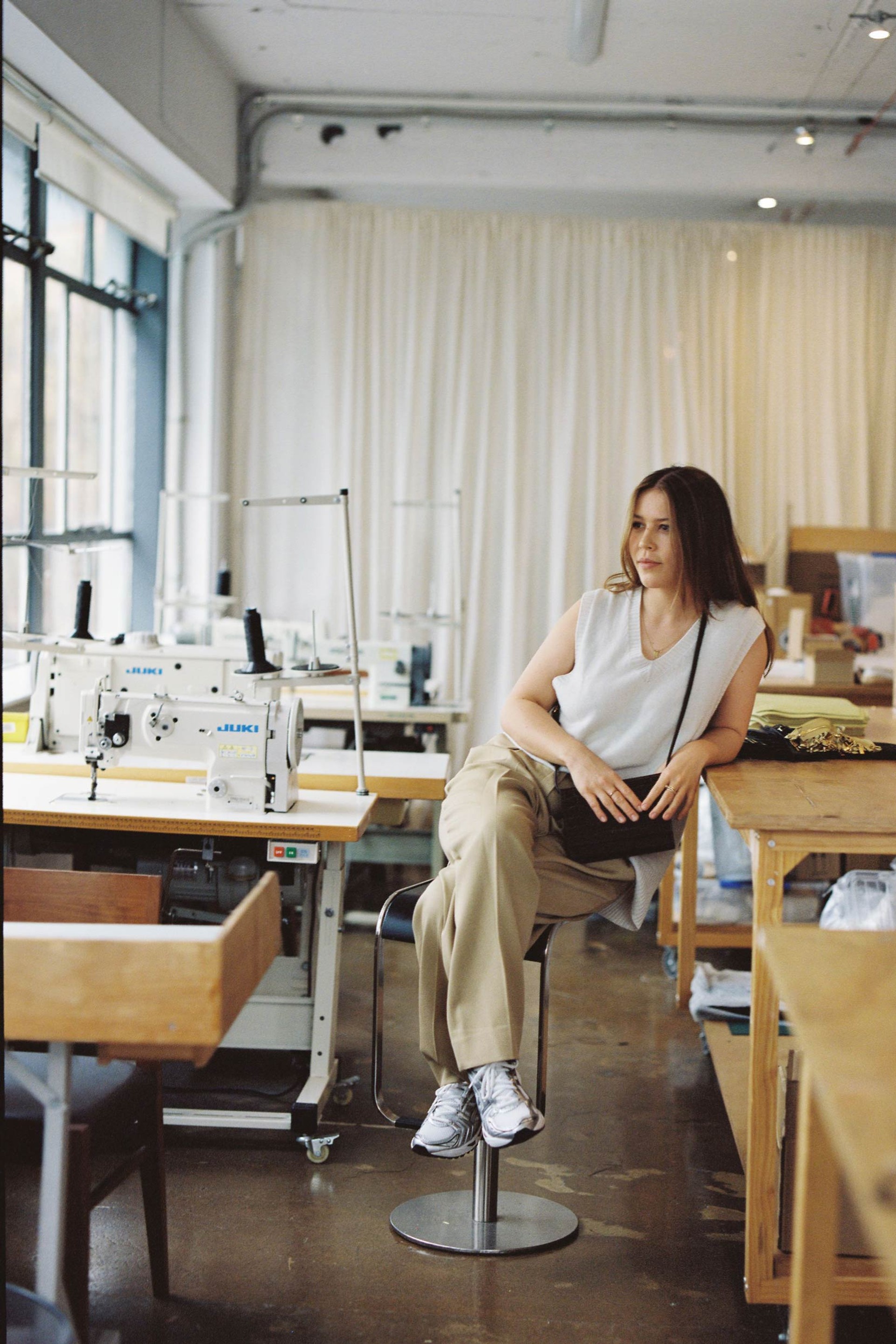In Conversation: Nikau Hindin, Jessie Wong & Jade Townsend
Nikau Hindin and Jessie Wong with their collaborative works.
In celebration of Matariki, Nikau Hindin and Yu Mei were invited into a Māori led Matariki kaupapa co-ordinated by Jade Townsend, titled Whānau Mārama ('Celestial Bodies'). Whānau Mārama is a cluster of exhibitions by contemporary Māori artists over the Matariki observation period. We joined a group of our fellow retailers in Commercial Bay, whose stores have been reimagined as spaces for artists and their taonga to be displayed.
To launch the exhibition and our special collaboration with artist Nikau Hindin (Te Rarawa, Ngāpuhi and Ngai Tūpoto), we held an Artist Kōrero event where Nikau and Jessie spoke with curator Jade Townsend (Ngāti Kahungunu) on the project. Read on to discover how Nikau’s work and research connects her to her Māori sense of place, how Jessie’s Chinese culture is woven into the design of each bag, and how these two cultural influences have interacted in the works.
Jade: Working with Māori artists, and having spent a lot of time in galleries and luxury shopping spaces, I have observed that an audience coming into a gallery can be quite critical - picking apart ideas and concepts, whereas an audience coming to visit their favourite brand is looking to be impressed. They want to learn about the processes and materials. The knowledge exchange is heightened and has potential to engage an audience in a meaningful way. That’s why I wanted to bring some of my favourite Māori artists into Commercial Bay and partner with New Zealand brands. We have these three pieces behind us, and I believe Jessie chose these for the canvas material which speaks to the fibre qualities of aute that Nikau usually works with. Nikau, what were some of the challenges that came with [painting on] canvas over a kind of silky aute?
Nikau Hindin: I was thinking about these beautiful bags that Jessie made and beautiful objects are easier to make more beautiful. So I was really lucky that the forms are so sculptural and really lend themselves to patterns. I don’t think I’ve painted on canvas since I was in high school. So it was a bit of a throwback, remembering how it sucks the ink. It’s very different to painting on aute. It’s much smoother in some aspects. I loved painting on the leather, using leather paint, and following the lines of the bags, and the perfect mathematics of the bags. Which I really enjoyed, because in my pattern making, I'm always thinking numbers and trying to find the angle. I think if the math is right, then the pattern will be right as well. I think this is quite a similar process with my aute, I paint on different types of plants, different ages of plants, and they all come in different shapes and sizes. So everything I paint is specific to the shape of the aute piece. Rather than trying to impose a structure onto it, I just go with whatever is there, so that’s how I came to do this.
Jade: When we first brought these bags into the shop last week, it was amazing to hear Nikau kōrero about maths and for Jessie to say, I’m totally with you on the numbers thing. That’s an amazing cultural connection that came out in your kōrero and process—symmetry, form and reflection. Numbers are very important to you both, can you share your insights Jessie?
Jessie: Yes, for those of you who don’t know, I am a third generation Chinese New Zealander. Yu Mei is my Chinese middle name. When I am making or creating a pattern, numbers and symbolism come into what I put together. Nothing will ever end in a ‘4’ in a measurement in a Yu Mei bag, as 4 is really bad luck, and actually buildings in China will skip the number 4. So it’s 1,2,3,5. So that’s always sort of an inspiration. And 3,7,8,9, are my lucky numbers. I guess it’s things that I didn’t notice I was doing as a designer until somebody asked what my influences are. I think it’s just something that’s inherent in my thinking. One of our best selling bags, the Braidy Bag, features a side panel that has 3 pieces of hardware, and you’ll always see Yu Mei designs with that kind of balance. I think balance is a big consideration in design.
Jade: I love that, because a huge part of this project is the knowledge exchange between the designers and the artists. It’s been amazing to see your friendship flourish during this, and along with your team as well Jessie. The idea was to create something that could be a pathway to an ongoing collaboration, and who knows what that looks like. For this to be an initial step into each other’s worlds it is a really organic outcome. And I know Nikau you said it’s easy to make something [that’s] beautiful more beautiful, but actually the restraint in what Nikau has done is really stunning. The patterns don’t battle with the architecture of the bags, and they feel so natural to me, like it’s pre-designed. I think that speaks so much to your amazing compositions and design sensibilities for new materials. [To Nikau] do you mind speaking a little bit about your star maps and where your patterns come from?
Nikau: I first started doing star maps in Hawai’i when I was trying to remember where different stars rise on the horizon, which is called the declination, and that’s what our maata ngā waka whenua, our navigators, used—stars on the horizon. [Nowadays] you’d use the sun—you know where the sunrise is, and you know where North, South, East and West are so you can orient yourself. And so that was my initial investigation into the spatial awareness of where the stars rise, and then I started to move onto time, and actually Matariki was a big influence on my research. I became interested as Matariki is ‘rising in the morning,’ so it’s a morning star at this time, but what’s it doing for the rest of the year? So I started looking at that pattern of when is it rising? When is it setting? Where is it in the night sky? In about April, we see Matariki setting in the Western horizon. So I would say it is like diving down. And then we don’t see it for about four weeks—it’s underneath us, when there is darkness, then it comes up around the other side and we see it rising on the Eastern horizon. I think about how our ancestors are. We have names of the whare that they visit during the four weeks that they're going underneath us, and the end of the Māori year. It’s my consciousness about time that really drove me to make these star maps, so that I could understand the patterns of the sky. I think I learn in patterns, repetition and doing the same map, so it became easy for me to memorise where the stars rise and set, and also to memorise where they are during the year. The names of our months are the names of our morning stars that we see rising in the morning. You use that early morning time to observe the stars and that’s an indication of what month we are in, and it has signs of what that month is for. Because time is so important, and our sense of time is what grounds us. The Gregorian calendar kind of rules our life, so getting in touch with our Māori sensibility of time is a way of decolonising, and learning more about where you are in space and time. I think that’s what I’m interested in.
Jade: Something that was really important in this collaboration and the project overall was to try and follow the Māramataka [Māori lunar calendar] and take note of the high energy days, the restful days, and be really conscious of where people might be at. I know Matariki is a high mahi phase for Māori artists, and it will continue to grow as the public holiday begins next year. So thank you so much for making time for this because I know you are across a lot of different projects.
Jessie: Our bags are all named after the personalities of the people who are close to me, who had a need that wasn't being met. They’re not celebrities—it’s really about this utilitarian, practical way of thinking and moving through the world. The bag at the top is named after an incredible business woman, her name is Claudia Batten. She’s an inspiration and mentor to me. A feature of that bag is there is a pocket on the back that unzips and slides over your suitcase handle. I guess another really important feature of the bags is the deer nappa that they’re made from. New Zealand farmed deer not only have a really low ecological footprint, but they are a byproduct of the venison industry and would otherwise be waste or landfilled. So it’s really sad, but probably one of the most glam food waste products out there. The middle one was named after Milly Hewat-Wall, who is here today. Milly is an incredibly driven, hardworking woman who has supported Yu Mei through our growth, especially up here in Tāmaki Makaurau. We really appreciate that. So that bag is for running around town and doing all the things you need to do in a day. Obviously it reflects the style of the Claudia Bag as well. The Adrian Envelope is named after our incredible production and design manager Adrian. Adrian is South African, he came over here probably about 6 years ago. He has an amazing and incredible skill set and craft and his job in South Africa was basically with bridal couture, so that translated really well to the meticulous nature of crafting leather, which is not that prevalent here in Aotearoa. It’s something that I learnt, and then taught to him, and we have sort of kept that alive together. So that’s a really special piece. That one is to house your travel documents and essentials. Adrian loves to travel and be a part of many different cultures, so that’s what that one is named after.
Jade: We thought we would do a ‘What's in Nikau Hindin’s bag’ until we realised how unglamorous that actually was. It was like doggy poo bags, and, um, we will leave it there [laughs]. But they are big enough and sturdy enough to carry books and fruit and nappies, and all of this broad variety of stuff in your life, from the ordinary to the treasures.
Bag 0
Duties and taxes included for Australia and New Zealand
Carbon Neutral Shipping
Shipping
| New Zealand | Complimentary Shipping over $50 NZD, Complimentary Returns, Click & Collect |
| Australia | Complimentary Shipping over $200 AUD |
| Rest of World | Complimentary Worldwide Shipping over $200 USD |
Areas
| New Zealand | Orders shipped within 2-3 working days, sent via tracked Courier Post. |
| Australia | Orders shipped within 2-3 working days, sent via tracked DHL Express |
| Rest of World | Orders shipped within 2-3 working days, sent via tracked DHL Express |
New Zealand and Australia
Taxes and duties are included within the purchase price.
Rest of World
As orders are shipped from our New Zealand warehouse you may incur duties, clearance fees or local taxes. Yu Mei Ltd does not cover these charges and is not liable for any fees incurred; although we will always do our very best to ensure a smooth delivery to you. For more information, we advise you to check with your local customs agent.
Choose Your Shipping Region / Currency
Change Region / Currency
Join
Club Yu Mei
Club Yu Mei is a community of like minded, forward thinking individuals. It’s a place to celebrate those who inspire the Yu Mei brand and beyond. From interviews and ideas to events, debates, dinner parties and more, the Club is an inclusive space by real people, for real people. Unlock our cabinet de curiosités and discover the thought-provoking universe of Club Yu Mei.
Search
Popular Searches
Choose Your Shipping Region / Currency
By continuing to use this site you consent with our cookie policy.
To stay abreast of all things Yu Mei, join our Club newsletter and enjoy 10% off your first purchase.





